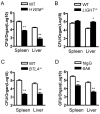B and T lymphocyte attenuator tempers early infection immunity
- PMID: 19587015
- PMCID: PMC2895307
- DOI: 10.4049/jimmunol.0801866
B and T lymphocyte attenuator tempers early infection immunity
Abstract
Coinhibitory pathways are thought to act in later stages of an adaptive immune response, but whether coinhibition contributes to early innate immunity is unclear. We show that engagement of the newly discovered coinhibitory receptor B and T lymphocyte attenuator (BTLA) by herpesvirus entry mediator (HVEM) is critical for negatively regulating early host immunity against intracellular bacteria. Both HVEM(-/-) and BTLA(-/-), but not LIGHT(-/-), mice are more resistant to listeriosis compared with wild-type mice, and blockade of the BTLA pathway promotes, while engagement inhibits, early bacterial clearance. Differences in bacterial clearance were seen as early as 1 day postinfection, implicating the initial innate response. Therefore, innate cell function in BTLA(-/-) mice was studied. We show that innate cells from BTLA(-/-) mice secrete significantly more proinflammatory cytokines upon stimulation with heat-killed Listeria. These results provide the first evidence that a coinhibitory pathway plays a critical role in regulating early host innate immunity against infection.
Figures





References
-
- Sharpe AH, Freeman GJ. The B7-CD28 superfamily. Nat Rev Immunol. 2002;2:116–126. - PubMed
-
- Croft M. Co-stimulatory members of the TNFR family: keys to effective T-cell immunity? Nat Rev Immunol. 2003;3:609–620. - PubMed
-
- Chen L. Co-inhibitory molecules of the B7-CD28 family in the control of T-cell immunity. Nat Rev Immunol. 2004;4:336–347. - PubMed
-
- Barber DL, Wherry EJ, Masopust D, Zhu B, Allison JP, Sharpe AH, Freeman GJ, Ahmed R. Restoring function in exhausted CD8 T cells during chronic viral infection. Nature. 2006;439:682–687. - PubMed
Publication types
MeSH terms
Substances
Grants and funding
LinkOut - more resources
Full Text Sources
Medical
Molecular Biology Databases
Research Materials

